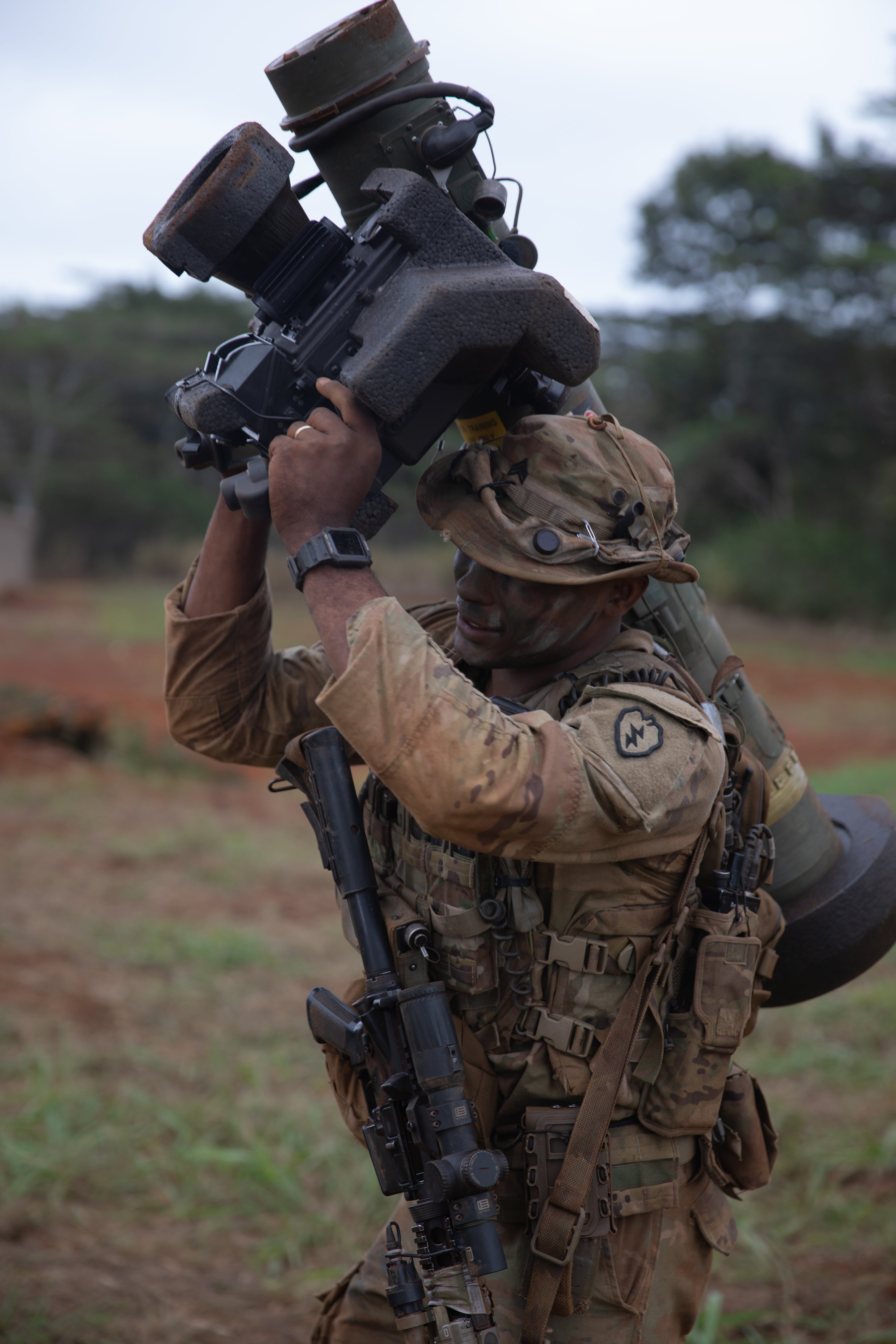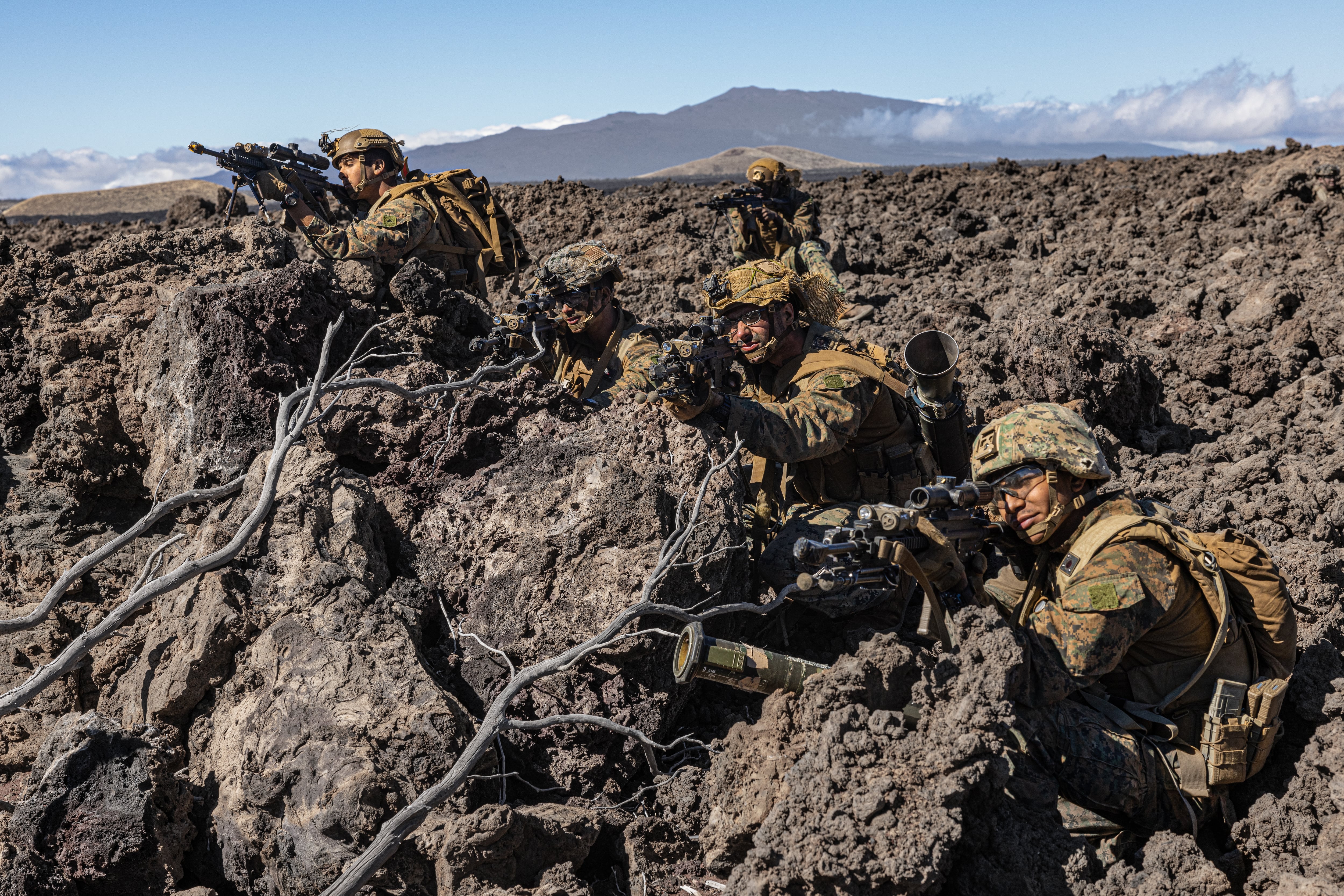Soldiers with the 25th Infantry Division in Hawaii recently wrapped a two-week exercise that included simultaneous offensive attacks and defensive maneuvers for a brigade stretched across multiple islands and hundreds of miles of ocean.
The Joint Pacific Multinational Readiness Center exercise focused on large-scale combat against a peer adversary with advanced military equipment.
Infantry, artillery and reconnaissance soldiers teamed with Marines from the 3rd Marine Littoral Regiment, special operators from the United Kingdom and the Army’s 1st Special Forces Group, Air Force Special Tactics and a variety of air force transport to seize airfields and the Army’s 3rd Multi-Domain Task Force for long-range fires and intelligence.
The joint force exercise also included Pacific partner nations. That included a company of Thai infantry, a battery of New Zealand artillery, a platoon of Indonesian infantry and special operations forces and advisors from the United Kingdom. More than 5,300 troops in total participated in the exercise, which ran from Nov. 1-10.
“That type of challenge the brigade faced is something we only see here at JPMRC, it’s really designed to train a brigade that’s headed out to Operation Pathways,” Col. Dave Zinn, 25th Infantry Division deputy commander for operations, told Army Times. Operation Pathways is a growing effort by the Army to join units from the service with Pacific partner forces in the partner’s home nation, and culminates in battalion and brigade-sized combined live fire exercises.
Combining multi-service and foreign nation assets across a chain of islands, with fires coming from as far as 4,000 miles away and thousands of troops, artillery, vehicles and other gear moving quickly across hundreds of miles between the Hawaiian Islands helps soldiers replicate scenarios they could face across the Pacific.

JPMRC is the Army’s newest combat training center. Brigades conduct their pre-deployment certification at the facility for Operation Pathways.
Zinn formerly served as a battalion commander with the 25th Infantry Division about a decade ago. At that time JPMRC did not exist and units, such as his, slated for an Afghanistan deployment had to travel stateside to do pre-deployment certification at the Joint Readiness Training Center Fort Johnson, Louisiana, formerly Fort Polk.
“That, of course, involves loading equipment onto ships, sailing those to a port in California or Texas and then loading onto trains for Fort Johnson,” Zinn said.
That ate up a lot of precious training time.
“We did some very good small unit training in Hawaii, but what we didn’t do, or have the opportunity to take advantage of, was large scale training like this,” Zinn said.
One soldier who’s seen both sides of training at JPMRC in Hawaii is Capt. Theodore Davis, the commander of Bravo Company with 2nd Battalion, 35th Infantry Regiment, 3rd Brigade Combat Team, 25th Infantry Division, the brigade that ran through the recent JPMRC certification.
Davis deployed previously in Operation Pathways, served as an opposition force soldier in last year’s training cycle against another 25th Infantry Division brigade, and commanded Bravo in this month’s exercise.
His company alone deployed at Kawaihapai Airfield, formerly known as Dillingham Army Airfield to start the exercise.
That’s a shift from last year, because that airfield is further out from the rest of the training area and gives a more realistic feel for how soldiers would deploy in such an island environment, Zinn said.
Davis’ company fell under 3rd Squadron, 4th Cavalry Regiment early in the exercise, conducting zone reconnaissance to identify enemy locations early in the simulated battle.
After nearly four days of recon, they moved back to the brigade, which had seized another airfield to set up an “air bridge” using Air Force C-17s and C-130s, moving personnel and equipment over 200 miles between island training sites.
Bravo Company continued assaulting and seizing terrain, working with the Indonesian infantry platoon and the 3rd Marine Littoral Regiment as they secured flanks along the main assault route, he said.

Even at the company level, Davis said the brigade pushed down electronic warfare personnel and drones to help locate enemy troops and coordinate supporting fires.
Zinn said that added EW, cyber, space, drone and counter-drone assets were new features of this year’s exercise compared with past events.
As the units continued their assault, rear elements faced an attack from the opposing force. This pushed the brigade to fight both offensively and defensively while being stretched across hundreds of miles of terrain.
At the same time, the 3rd Multidomain Task Force helped coordinate fires from 4,000 miles away in Palau, as part of the exercise, Zinn said.
Having that many assets at a brigade’s disposal and affecting movements down to the company or platoon level isn’t the norm for many training events, Davis said.
But all of it allows soldiers to know their craft at such a level that they can help partners improve as they deploy across the region.
“We essentially sharpen our sword so that we can go assist the other countries in sharpening theirs,” Davis said.
Following this certification, 3rd Brigade Combat Team, 25th Infantry Division is now on deck for its 2024 Operation Pathways deployment.
Zinn said there are already planning a major exercise in the Philippines early next year with events at other locations in the region to come later in 2024.
Todd South has written about crime, courts, government and the military for multiple publications since 2004 and was named a 2014 Pulitzer finalist for a co-written project on witness intimidation. Todd is a Marine veteran of the Iraq War.





